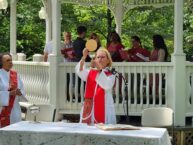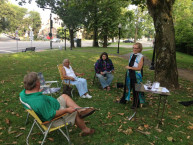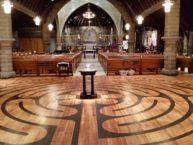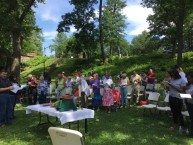 April 9, 2017 – Palm Sunday: May God’s words alone be spoken, may God’s words alone be heard. Amen.
April 9, 2017 – Palm Sunday: May God’s words alone be spoken, may God’s words alone be heard. Amen.
A few months ago, I realized just how educational Facebook can be, seriously. Now, we all know about the C&E crowd, right? The folks that only come to church on Christmas and Easter. Well, I found out from a Roman Catholic friend of mine’s comment on Facebook about something called PACE Catholics – you come only on major holidays, and days when there’s a giveaway: Palm Sunday, Ash Wednesday, Christmas, & Easter. PACE! Who knew? So, welcome any PACE folks out there.
But Facebook’s trove of useful stuff doesn’t stop there, and no, I am not talking about finding out which Harry Potter House you belong in, or what Star Wars character you are (fun, but really not all that helpful). For liturgical geeks, there were multiple Facebook conversations about why, when, and how the reading of the Passion ended up on Palm Sunday, and the answers were as varied as the questions they raised.
Now, if you’ve been coming here awhile, than you already know what I am talking about here, but if not, here’s the thing: we are about to do something here on Palm Sunday that we really shouldn’t be doing, and didn’t do for most of our history…move from palm to passion in a single service. Despite the insistence by at least one priest that it wasn’t in response to declining attendance at Holy Week services, there seems to be an avalanche of folks who claim otherwise. The idea being that if we don’t have the passion on Palm Sunday (and many still don’t), than many folks will go from “Glory to Glory” – from the triumphal entry into Jerusalem to the victory over death in the empty tomb – and that, that truly would be an Easter robbed of meaning. So, while this really should just be Palm Sunday, with the passion being our Holy Week journey, we do include it, because Easter, without the passion, is an empty experience.
So, the result is that Palm Sunday becomes a wild rollercoaster ride of emotions – from the near carnival atmosphere of the procession of the palms, to the horror of the cross. And this year, it will be an exceptionally engaging entry into Holy Week, as we are blessed to have the Dzieci Theatre company here to perform the passion, which promises to be something that will push our imaginations, engage our senses, and challenge our assumptions. Which is in itself – something Holy Week is meant to do, right?
One of the things we sometimes miss on this Sunday, in our haste to move from palm to passion, is this last line from the gospel we heard just before our celebratory procession this morning. After all the donkey and colt stuff – after the cloaks and palms and shouts of Hosanna – the author of the gospel wrote “When he entered Jerusalem, the whole city was in turmoil, asking, “Who is this?”
“Who is this?”
Of course, the quick answer to “who is this,” is Jesus the Christ. But for that to mean something to us, we need to understand who Jesus was – and the passion reveals this to us in surprising ways. Yes, there is the cross, the willingness to die that the world might be changed – that we might be changed. But in the actions leading up the cross, Jesus is trying to tell us more.
Just before the passion narrative in the gospel of Matthew, Jesus tells his disciples perhaps the most important lesson they, or we, will receive – and it is about who he is. Using the setting of a final judgement, he says about those who will be declared righteous, “…for I was hungry and you gave me food, I was thirsty and you gave me something to drink, I was a stranger and you welcomed me, I was naked and you gave me clothing, I was sick and you took care of me, I was in prison and you visited me.” And when perplexed as to how they had done that, the answer came, “Truly I tell you, just as you did it to one of the least of these who are members of my family, you did it to me.” In the passion itself, Jesus takes it a step further, washing the feet of his disciples as a model of servant ministry, a symbol of his commandment to love one another.
Who is this? It is Jesus. Who is Jesus? Jesus is the stranger, the imprisoned, the hungry, the sick – the loving servant – the crucified one.
We often are left to wonder about the inhumanity of crucifixion – how could a government do that to another human being. Perhaps that is why this enactment we will experience here today by Dzieci is so powerful, because it is set not in the ancient near east, but in the Warsaw ghetto of our 20th century, where “the death toll among the Jewish inhabitants of [this Nazi created neighborhood prison] is estimated to be at least 300,000 killed by bullet or gas,[8] combined with 92,000 victims of rampant hunger and hunger-related diseases, the Warsaw Ghetto Uprising, and the casualties of the final destruction of the Ghetto.”[1] It is a reminder to us of what can happen when we fail to see the Jesus in the other. When we turn our backs on the crosses being erected outside our city walls. When we look at another as being “them” rather than “Him.”
No, the passion isn’t something that just happened over 2,000 years ago. The passion is a story happening now, because Jesus is being crucified all over the world, not only by governments, but by our own greed, hatred, and neglect. The crucifixion of Jesus, is happening today, because today – Jesus is the trans-teen left for dead after being savagely beaten. Today – Jesus is the immigrant being torn from his family. Jesus is the black man shot in the back and laying in a pool of his own blood. Jesus is the Jewish widow trembling in fear, anger, and heartbreak in a cemetery of toppled headstones and swastikas. Jesus is the Muslim woman holding her head high while pelted with slurs and catcalls. Jesus is the refugee hoping to find a safe home. And Jesus is the Syrian child gasping for breath – covered in Sarin gas.
You know, one news commentator remarked this week about the attack on the Syrian airbase that came in response to the gassing of men, women, and children by Assad, the ruler of Syria. The news anchor noted “Missiles always change the subject.”
Well, my friends, so do crosses.
Crosses change the world. Or really, crosses are a sign that the world is changing…and some folks are afraid of it and are trying to kill it.
That’s the thing – our focus on the cross can sometimes blind us to why the cross happened in the first place – to the life that so threatened the status quo – the cross was the response. 51 years ago this week, on April 4th, the Rev. Dr. Martin Luther King, Jr. was shot dead on a hotel balcony in Memphis. And yet the message of his life is not to be found in the image of a Remington rifle, but in his witness to the love God has for all the people of the world – that all should be free. The rifle was just a symbol of the resistance to the change he was bringing into the world. Dr. King understood that for his faith to have any meaning, he had to be Jesus in the world – shining a light on the darkness of bigotry, walking with love in the shadowland of hate, and standing with the Jesus in the poor and marginalized people of color. That was his call…and that is our call too.
We are no longer able to be Christian, and have a neat and tidy faith wrapped up on a Sunday and made known by a cross around our necks…really, we never were, we only convinced ourselves that was enough. Well, it isn’t. Not by a long shot.
Who is this? This is Jesus. Who is Jesus? Jesus is you.
This is you!
Jesus is not only the crucified one…he is also you, and me – the body of Christ in the world today. That is why it is so powerful that the role of Jesus in the passion today will go from person to person in the company, male to female, young to old. Because Jesus is in all of us too. There is a reason St. Paul, in his letter to the Philippians is calling us to “Let the same mind be in you that was in Christ Jesus.” The same Jesus that offers up his life, is the same one that bent his knee in love to show us how to live as he lived – calling us into that identity.
The tyranny of the world is the passion of our time, and we cannot walk away from it. It is not only our civic duty to speak truth, to act for justice, to work for peace – it is the call of every one of us as a follower of Christ. And when we see crosses, it isn’t because we are failing, but because we are succeeding, yet we will not be deterred. We know the cross isn’t the last word. It never was.
Palm Sunday invites us into Holy Week – invites us into the questions – who is this, who is Jesus, who am I, what does all this mean for me…for the world? Maybe it makes sense that it is a crazy and chaotic service…it’s what you might expect starting the journey of a lifetime.
Amen.
For the audio from the 10:30am service, click here:
[1] Holocaust Encyclopedia (June 10, 2013) [2008]. “Warsaw Ghetto Uprising”. US Holocaust Memorial Museum. Archived May 2, 2012, at the Wayback Machine.
Rev. Diana L. Wilcox
Christ Church in Bloomfield & Glen Ridge
April 9, 2017
Palm Sunday
1st Reading – Isaiah 50:4-9a
Psalm 31:9-16
2nd Reading – Philippians 2:5-11
Gospel – Matthew 21:1-11






